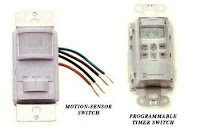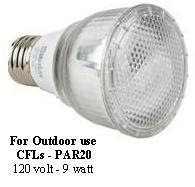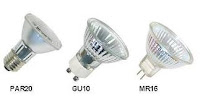Q. I have some pot lights installed in my home; I noticed that they often blink. Why does this happen?
A. Blinking is when the light goes on and off intermittently due to overheating. This can occur for a couple of reasons, first when the light fixture is installed in an insulated area without a proper IC box and/or installing a bulb of a too high wattage. Most pot lights are thermally protected. The thermal protector is a security device which is located inside the pot light and its function is to shut off the pot light if the temperature rises to an unacceptable level. After a while the temperature of the pot light drops and goes back to normal causing the pot light to turn on again.
A. Blinking is when the light goes on and off intermittently due to overheating. This can occur for a couple of reasons, first when the light fixture is installed in an insulated area without a proper IC box and/or installing a bulb of a too high wattage. Most pot lights are thermally protected. The thermal protector is a security device which is located inside the pot light and its function is to shut off the pot light if the temperature rises to an unacceptable level. After a while the temperature of the pot light drops and goes back to normal causing the pot light to turn on again.
Q. It’s very uncomfortable coming home at night to a dark house, are there products available that automatically turn on lights so it looks like someone is at home and not seem dark?

A. Lights can automatically be switched on/off by timers, which can be set to turn on at sunset at a specific time and off at sunrise at a specific time. The timer also adjusts to time change. Motion sensor is another option, used for security, convenience, or energy savings, a motion-sensor switch turns on a light (or lights) when it detects movement in the area.
 A. Yes, there are outdoor bulbs available that have a long lifespan plus saves on energy at the same time. Compact Fluorescent Bulbs (CFLs) are one of them. CFLs cost a bit more that an incandescent, but it saves you money in the long run because they use 75% less electricity to produce the same amount of light as an incandescent bulb and last up to 10 times longer(usually around 10,000 hours). It is estimated that a CFL pays for its higher price after about 500 hours of use. CFL come in different shapes, sizes, and colors of light. For outdoors, check the package to make sure the bulb can be suited for outdoor use.
A. Yes, there are outdoor bulbs available that have a long lifespan plus saves on energy at the same time. Compact Fluorescent Bulbs (CFLs) are one of them. CFLs cost a bit more that an incandescent, but it saves you money in the long run because they use 75% less electricity to produce the same amount of light as an incandescent bulb and last up to 10 times longer(usually around 10,000 hours). It is estimated that a CFL pays for its higher price after about 500 hours of use. CFL come in different shapes, sizes, and colors of light. For outdoors, check the package to make sure the bulb can be suited for outdoor use.
Q. What are some energy saving tips?
A. Assuming the average household the lighting consume 15% to 20 % of the all electrical power connected. You should be alert about installing new lighting or making a few changes in your present habits. You can cut your energy consumption and costs if you follow some of these saving energy tips:
• Paint your walls with light colors
• Take advantage of daylight
• Buy compact fluorescent and LED bulbs
• Clean light bulbs regularly
• Replace incandescent lights with energy-saving lights
• Use the lowest-wattage light bulbs possible
• Install dimmers instead of switches to control your light fixtures.
• Install timer switches for outdoor lights
• Use low-voltage garden lights instead of line voltage lights
• Install motion detectors and photocells outdoors
• Use solar power lights for lawn and garden
• Turn off lights when you leave a room
A. Lights can automatically be switched on/off by timers, which can be set to turn on at sunset at a specific time and off at sunrise at a specific time. The timer also adjusts to time change. Motion sensor is another option, used for security, convenience, or energy savings, a motion-sensor switch turns on a light (or lights) when it detects movement in the area.
Q. I bought a light fixture with a socket rated for 75 watt; can I use a 100 watt light bulb?
A. No. The wattage rating of the socket should never be exceeded. When purchasing the fixture the label in the socket shows you the rate for a maximum wattage input. Remember that installing a bulb of too-high wattage overheats the fixture, causing bulbs to burn out quickly, damaging the fixture and the ceiling material, and creating a potential fire hazard. If you need more light than the fixture can deliver, replace the fixture.
Q. What makes the pot light installation in the top floor (below attic) more expensive?
A. It is more expensive because additional labour and materials are required to install pot lights on the top floor (below attic). All pot lights installed in insulated areas must be totally enclosed in a metal box (insulated ceiling box), which keep the hot pot lights away from the attic insulation, Otherwise can be a fire hazard.
Q. What is the difference between Incandescent and Halogen Light Bulbs?
A. Both incandescent and halogen light bulbs use a filament to produce light. However, halogen bulbs are designed to operate more efficiently than incandescent bulbs because the filament is encased in a glass capsule, in a halogen gas atmosphere. These bulbs produce a brighter, whiter beam and last longer than incandescent sources, at least three times longer than equivalent incandescent bulbs. They’re excellent and unmatched for task lighting, pinpoint accenting, and other dramatic effects. One of disadvantage of halogen bulbs, besides being more expensive, is that it’s very hot and it must be used in fixtures specifically designed and approved for it.
Both incandescent and halogen light bulbs use a filament to produce light. However, halogen bulbs are designed to operate more efficiently than incandescent bulbs because the filament is encased in a glass capsule, in a halogen gas atmosphere. These bulbs produce a brighter, whiter beam and last longer than incandescent sources, at least three times longer than equivalent incandescent bulbs. They’re excellent and unmatched for task lighting, pinpoint accenting, and other dramatic effects. One of disadvantage of halogen bulbs, besides being more expensive, is that it’s very hot and it must be used in fixtures specifically designed and approved for it.
Q. What should I consider by replacing my switches with dimmers?
A. You must get a dimmer that matches your voltage and the bulb type. Standard-voltage incandescent and halogens are relatively easy to dim. You need a low-voltage dimmer for low-voltage lights. Dimmers are rated for maximum wattage. For line-voltage models, 600 watts is the standard; you can also find 1,000-watt versions. Some low-voltage dimmers may handle only 300 watts.
Fluorescent lights require fluorescent dimmers and, just as important, a dimming ballast in the fixture itself. This can be a problematic retrofit- it may be easier to simply replace an existing fixture with one that’s dimmable. Solid-state dimmers and ballasts work best.
A. No. The wattage rating of the socket should never be exceeded. When purchasing the fixture the label in the socket shows you the rate for a maximum wattage input. Remember that installing a bulb of too-high wattage overheats the fixture, causing bulbs to burn out quickly, damaging the fixture and the ceiling material, and creating a potential fire hazard. If you need more light than the fixture can deliver, replace the fixture.
Q. What makes the pot light installation in the top floor (below attic) more expensive?
A. It is more expensive because additional labour and materials are required to install pot lights on the top floor (below attic). All pot lights installed in insulated areas must be totally enclosed in a metal box (insulated ceiling box), which keep the hot pot lights away from the attic insulation, Otherwise can be a fire hazard.
Q. What is the difference between Incandescent and Halogen Light Bulbs?
A.
Q. What should I consider by replacing my switches with dimmers?
A. You must get a dimmer that matches your voltage and the bulb type. Standard-voltage incandescent and halogens are relatively easy to dim. You need a low-voltage dimmer for low-voltage lights. Dimmers are rated for maximum wattage. For line-voltage models, 600 watts is the standard; you can also find 1,000-watt versions. Some low-voltage dimmers may handle only 300 watts.
Fluorescent lights require fluorescent dimmers and, just as important, a dimming ballast in the fixture itself. This can be a problematic retrofit- it may be easier to simply replace an existing fixture with one that’s dimmable. Solid-state dimmers and ballasts work best.
Q. I live in a two storey house. It's difficult to change the outdoor pot light bulbs. Are there any bulbs that have a long lifespan plus saves on energy?
Q. What are some energy saving tips?
A. Assuming the average household the lighting consume 15% to 20 % of the all electrical power connected. You should be alert about installing new lighting or making a few changes in your present habits. You can cut your energy consumption and costs if you follow some of these saving energy tips:
• Paint your walls with light colors
• Take advantage of daylight
• Buy compact fluorescent and LED bulbs
• Clean light bulbs regularly
• Replace incandescent lights with energy-saving lights
• Use the lowest-wattage light bulbs possible
• Install dimmers instead of switches to control your light fixtures.
• Install timer switches for outdoor lights
• Use low-voltage garden lights instead of line voltage lights
• Install motion detectors and photocells outdoors
• Use solar power lights for lawn and garden
• Turn off lights when you leave a room
Mapleleaf Electric Inc - Photos from previous potlights installations in the GTA.
Recessed lighting has become one of the most desired home improvements by homeowners, and for good reason. Not only does it enhance a home's interior, it makes each room comfortable at any hour of the day or night.
Copyright © 2014 Mapleleaf Electric Inc. All rights reserved.